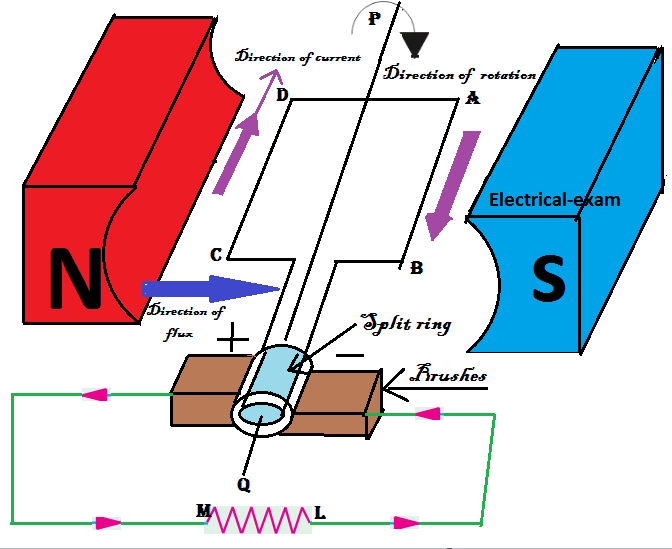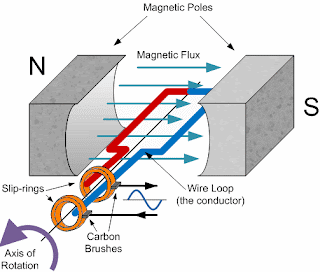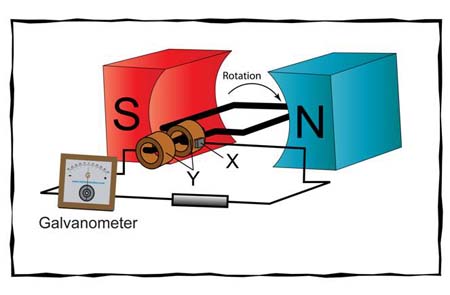Electromagnetic electric generator fall into one of two broad categories, dynamos and alternators.
- Dynamos generate direct current, usually with voltage or current fluctuations, usually through the use of a commutator
- Alternators generate alternating current, which may be rectified by another (external or directly incorporated) system.
Direct current generator
The dynamo was the first electrical generator capable of delivering power for industry. The dynamo uses electromagnetic induction to convert mechanical rotation into direct current through the use of a commutator. An early dynamo was built by Hippolyte Pixii in 1832.Woolrich Electrical Generator in Thinktank, Birminghamis the earliest electrical generator used in an industrial process.It was used by the firm of Elkingtons for commercial electroplating.
The “dynamo-electric machine” employed self-powering electromagnetic field coils rather than permanent magnets to create the stator field.Wheatstone’s design was similar to Siemens’, with the difference that in the Siemens design the stator electromagnets were in series with the rotor, but in Wheatstone’s design they were in parallel. The use of electromagnets rather than permanent magnets greatly increased the power output of a dynamo and enabled high power generation for the first time. This invention led directly to the first major industrial uses of electricity. For example, in the 1870s Siemens used electromagnetic dynamos to power electric arc furnaces for the production of metals and other materials.
The dynamo machine that was developed consisted of a stationary structure, which provides the magnetic field, and a set of rotating windings which turn within that field. On larger machines the constant magnetic field is provided by one or more electromagnets, which are usually called field coils.
Types Of DC Generator
-
Homopolar generator
It is also known as a unipolar generator, acyclic generator, disk dynamo, or Faraday disc. The voltage is typically low, on the order of a few volts in the case of small demonstration models, but large research generators can produce hundreds of volts, and some systems have multiple generators in series to produce an even larger voltage. They are unusual in that they can produce tremendous electric current, some more than a million amperes, because the homopolar generator can be made to have very low internal resistance.
-
MHD generator
A magnetohydrodynamic generator directly extracts electric power from moving hot gases through a magnetic field, without the use of rotating electromagnetic machinery. MHD generators were originally developed because the output of a plasma MHD generator is a flame, well able to heat the boilers of a steam power plant. The first practical design was the AVCO Mk. 25, developed in 1965. The U.S. government funded substantial development, culminating in a 25 MW demonstration plant in 1987. In the Soviet Union from 1972 until the late 1980s, the MHD plant U 25 was in regular commercial operation on the Moscow power system with a rating of 25 MW, the largest MHD plant rating in the world at that time. MHD generators operated as a topping cycle are currently (2007) less efficient than combined cycle gas turbines.
Alternating current generators
Alternating current generating systems were known in simple forms from Michael Faraday’s original discovery of the magnetic induction of electric current. Faraday himself built an early alternator. His machine was a “rotating rectangle”, whose operation was heteropolar – each active conductor passed successively through regions where the magnetic field was in opposite directions.
Large two-phase alternating current generators were built by a British electrician, J.E.H. Gordon, in 1882. The first public demonstration of an “alternator system” was given by William Stanley, Jr., an employee of Westinghouse Electric in 1886.
Types Of AC Generator
-
Induction generator
To operate an induction generator must be excited with a leading voltage; this is usually done by connection to an electrical grid, or sometimes they are self-excited by using phase correcting capacitors.
-
Linear electric generator
-
Variable speed constant frequency generators
Many renewable energy efforts attempt to harvest natural sources of mechanical energy (wind, tides, etc.) to produce electricity. Because these sources fluctuate in power applied, standard generators using permanent magnets and fixed windings would deliver unregulated voltage and frequency. The overhead of regulation (whether before the generator via gear reduction or after generation by electrical means) is high in proportion to the naturally-derived energy available.
New generator designs such as the asynchronous or induction singly fed generator, the doubly fed generator, or the brushless wound-rotor doubly fed generator are seeing success in variable speed constant frequency applications, such as wind turbines or other renewable energy technologies. These systems thus offer cost, reliability and efficiency benefits in certain use cases.





